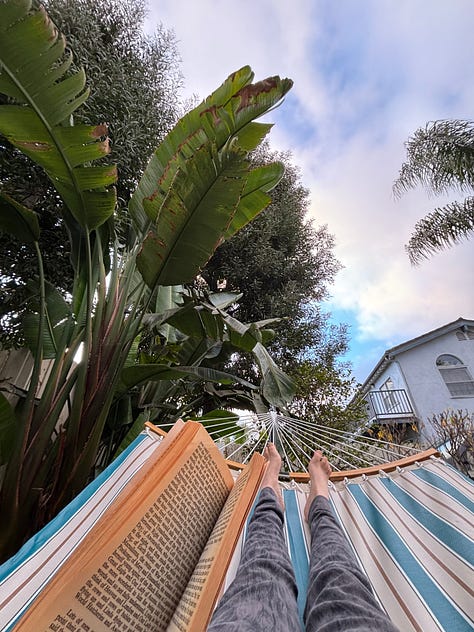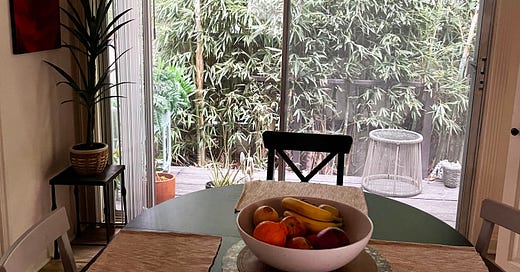On December 1, 2024, after nearly a decade bouncing between four different Los Angeles apartments, I moved into my first house.**
At first glance, the two-bedroom, 1940s-era ranch in Sherman Oaks doesn’t scream dream home. Nestled among towering McMansions and sleek newbuilds, it’s a bit of an oddball on its block—light-yellow siding, green shutters, a narrow, cracked driveway.
Plus, we found it on Craigslist (red flag? Maybe).
But as soon as I crossed the threshold, I was smitten. I loved the white-brick fireplace, the wall of thick bamboo outside the dining room window, the airy kitchen, and the yard (we have a yard!).
Everything seemed to fall into place. Within two weeks, our rental application was approved and my husband, Nick, and I moved in. By December 31, we had a hammock in the backyard, a festive spread of food and drinks on the dining room table and a home full of friends for a New Year’s Eve housewarming party. (Ever need a deadline to unpack a box? Try throwing a party three weeks after moving).
It was the perfect way to kick off 2025 — until Los Angeles caught fire six days later.



After years in LA, I’ve lived through my fair share of wildfires. I still remember standing on the roof of my old office in November 2018, watching ash from the Malibu (Woolsey) fire fall from a sherbet-orange sky. (Angelenos, you know the color.)
But the 2025 fires were different.
I don’t need to tell you what happened — the world watched in horror as flames, driven by Santa Ana winds and dry conditions, tore through the Pacific Palisades and Altadena neighborhoods of Los Angeles. Homes, businesses, schools, and hiking trails were destroyed within a matter of hours.
Everyone in LA — and everyone who knows someone in LA — felt the devastation. A friend of mine, a teacher in the Palisades, watched as flames approached her school’s basketball courts. Keeping her second-graders calm, she got them to safety. Shortly after, she lost her classroom.
For days, I was in shock. I barely slept. I laid in bed, scrolling through updates, feeling helpless. Eventually, I pulled myself together, took a day off and volunteered at a shelter because I felt that I just needed to do something. At work, where my team of travel journalists covers disasters from a distance, we struggled.
This time, the story felt too close.
Three days after the fires began, I went to dinner at a friend’s house, hoping to escape the heaviness. Halfway through the meal, Nick called.
"I don’t want to worry you," he said (which, obviously, made me panic) "but the evacuation zones have moved to Sherman Oaks."
We flipped on the news. My stomach dropped as I saw the name of our street—our new street!—listed in the evacuation warning zone. (To clarify: an “evacuation warning” is not a mandatory order, but a strong suggestion to be ready to leave at a moment’s notice.)
I don’t remember much about the next hour. I sped home, called my mom, and asked her to read me the news updates as it streamed from her television, 2,000 miles away in Illinois.
I racked my brain: What do I need to pack? Paperwork? Passports? Flashlights? Where would we go—Nick’s parents’ place in Palm Springs? A friend’s house in Culver City?
By the time I walked through our front door, Nick had already packed two suitcases — one of which held our wedding album and five years’ worth of handwritten cards from every birthday, anniversary, and Valentine’s Day we’ve spent together.
I burst into tears.
Going room by room—past the wall of bamboo, the white fireplace, through the kitchen I had come to love in such a short time—I started grabbing items and throwing them into suitcases. (Did I really need my curling iron if we were told to evacuate? No. But did I throw it in anyway? Yep.)
I took a few things off the wall. I emptied my desk.
And then, a harrowing thought: What if I never come back here again?
I had only lived in this house for a month, but I had already envisioned our future here— years of experiences, milestones and quiet routines within these four walls.
A Lesson in Impermanence
Now, it’s not lost on me how lucky I am to have a happy ending to this story when so many others in my community didn’t. Some people had no warning at all, no time to pack a bag, no time to decide what to take.
Our house—with its yellow siding, green shutters and swaying, front-yard palms—is still standing. And although the evacuation warning lasted a torturous four days, we never had to leave.
Our homes are more than just structures. They are where we are our truest selves, where we feel safe, where we collect memories (or dream about the promise of them). They are the backdrop to our everyday lives. And sometimes, they are the only shelter we have from a world that is, quite literally, burning around us.
If I learned anything from this, it’s this: Nothing is promised. Nothing is guaranteed. Nothing is permanent. But one thing you can control? Preparation.
So, I ask you—whether you live in LA or not—what’s the plan? If an emergency hits close to home, would you know what to do?
If the answer is no (hello, me), here’s a list from FEMA to get you started:
✅ Prescription medications and glasses
✅ Infant formula and diapers
✅ Pet food, water, and supplies for your pets
✅ Copies of insurance policies, identification, and bank records in a waterproof container
✅ Cash and change
✅ A first aid book or emergency reference material
✅ Sleeping bag or warm blanket for each person
✅ Change of clothes, including long sleeves, pants, and sturdy shoes
✅ Fire extinguisher
✅ Matches in a waterproof container
✅ Feminine supplies, personal hygiene items, and hand sanitizer
✅ Paper cups, plates, utensils, and paper towels
✅ A notepad and pencil
Oh, and maybe throw in a curling iron.
Stay safe, my friends.
Wishing you a calm week ahead,
Emma Stern
(**Footnote: Let’s be clear—I’m renting. I am not rich enough to buy property in Southern California.)





